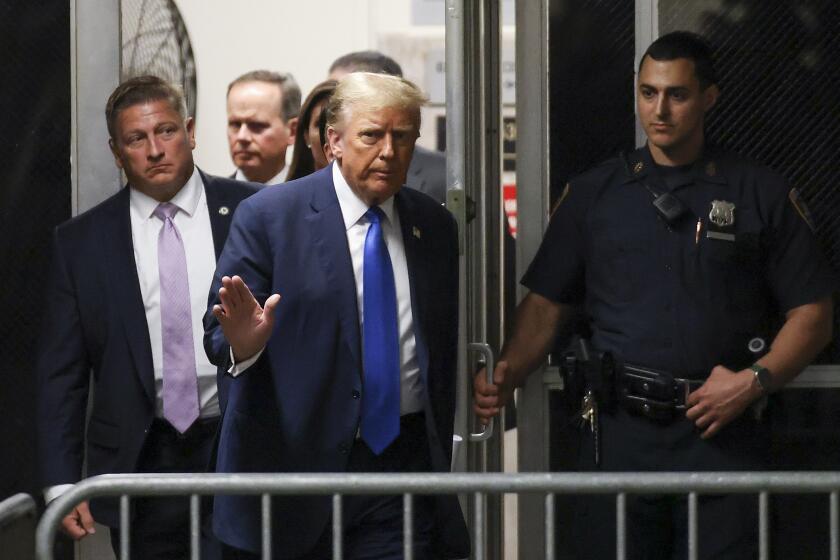Parties scour electoral map for final weeks
Entering the final stage of the race, the two presidential campaigns are plotting strategies that rely on vastly different readings of the electoral map, with Democrat Barack Obama competing hard in a large number of traditionally Republican states and John McCain, the GOP nominee, focusing on a small set of familiar battlegrounds.
A wild card in their calculations is McCain’s surprise vice presidential choice, Sarah Palin.
Strategists in both parties say it is too early to assess whether the Alaska governor’s conservative profile, which has energized core Republican voters, will put new states in play for the GOP ticket. A McCain campaign that has struggled with a lack of enthusiasm says it is already heartened by one post-Palin development: a wave of new GOP volunteers in Florida, Wisconsin and other crucial states.
National polls suggest the race is a tossup. In presidential contests, though, the trick is stringing together victories in enough states to clear a 270-vote majority in the electoral college.
With the election less than two months out, each campaign is reevaluating the map. Privately, McCain strategists acknowledge they are up against a mighty field operation assembled by the Obama campaign, which McCain’s team has been hard-pressed to match.
The Obama campaign’s worries include carrying Wisconsin and New Hampshire, two states that voted Democratic four years ago but are no sure thing this time around. They are also keeping a wary eye on Michigan, another Democratic state in 2004. Obama made two stops there Monday, talking about the slumping economy.
“We had no illusions that this was going to be anything but close,” David Axelrod, Obama’s lead strategist, told reporters recently.
Armed with the larger bank account, Obama’s plan has been to maximize his chances by trying to win states that were out of reach to Democrats in recent elections. He is making serious investments of staff and advertising in 18 states, 14 of which voted to reelect President Bush in 2004.
The idea is to hold on to all of the states that Democrat John F. Kerry won in 2004, then peel off enough traditionally Republican states to put Obama over the top. So, even at this late point in the contest, the Obama operation boasts dozens of paid staff and multiple offices in states such as Montana and North Dakota.
Other states that Republicans won in 2004, but which Obama is now targeting, include Colorado, Florida, Georgia, Indiana, Iowa, Missouri, Nevada, New Mexico, North Carolina, Ohio and Virginia. And the campaign says it is not abandoning its ambitions in Alaska, even after Palin’s selection as McCain’s running mate.
“One of our strategic goals here is to wake up on the morning of Nov. 4 with as many pathways to 270 electoral votes as possible,” David Plouffe, Obama’s campaign manager, recently told reporters. Nov. 4 is election day.
McCain campaign officials see a more constricted field of play. “Eighteen states is 10 states too many,” one McCain strategist said, dismissing the Obama campaign’s assessment of how to win.
In McCain’s view, the election hinges on several Rust Belt and Upper Midwest states, particularly Michigan, Ohio, Pennsylvania and Wisconsin, as well as the perennial battleground of Florida.
Some conditions in the battleground states seem to favor Obama. Voter registration in key states has been trending Democratic. In Pennsylvania, a state with 21 electoral votes, registered Democrats now outnumber Republicans by more than 1.1 million, up from 484,000 in 2000.
Republicans enjoyed a registration edge in Nevada and Iowa in the 2000 and 2004 elections. Not anymore.
Overlaid on the map is widespread disaffection with the Republican Party. Bush’s approval ratings have hit record lows. The economic slowdown and rising gas prices are ongoing worries.
In the face of these obstacles, Republicans see it as a victory of sorts that the race is as competitive as it is. Indeed, several recent polls show the race as close to dead even, and a USA Today/Gallup Poll survey made public Monday showed McCain ahead among registered voters, 50% to 46%.
“This is in many ways the best Democratic environment since Watergate,” said Mike DuHaime, political director for McCain. Given all the factors in his favor, he said, Obama “should be ahead by a lot.”
If the map were a roulette table, Obama would be dropping chips all over.
In Georgia, a state that hasn’t voted for a Democratic presidential candidate in 16 years, Obama maintains a paid staff of more than 100. He has opened more than 30 offices, attracted nearly 5,000 volunteers and registered more than 92,000 new voters there, according to the campaign. A nonpartisan study of TV advertising released at the end of July showed that Obama had aired more than $1.8 million worth of ads in Georgia over the previous seven weeks, compared with nothing for McCain.
McCain has no field office in Georgia, using instead a Florida-based office for the Southeast. Yet he has reason for optimism: An aggregate of public polls compiled by the website Pollster.com shows McCain with a 6-point lead in Georgia.
In a possible suggestion that Obama is shifting his bets, his campaign recently returned its advertisements to the air in several states, after removing them during the recent party conventions. But Obama’s ads have not gone on the air again in Georgia or Alaska.
Plouffe told reporters Monday that the campaign was moving some staff out of Georgia and into North Carolina -- a state that offers another illustration of Obama’s expansive view of the map.
No Democratic candidate for president has won North Carolina since Jimmy Carter in 1976. This year, Obama has sent more than 100 paid staff to the state. The same nonpartisan ad study, compiled in part by the Wisconsin Advertising Project, showed that Obama aired more than $1.6 million worth of ads in North Carolina over a seven-week period this summer, compared with none for McCain.
Yet Pollster.com showed McCain with a 3-point edge in North Carolina.
Montana is a small prize with just three electoral votes, but it has gotten considerable attention from the Obama campaign. Obama is airing TV commercials in the state, which last voted Democratic in the 1992 presidential race. He has opened 17 offices in Montana and visited the state five times, according to Democratic officials.
In the end, Republicans don’t believe it will make any difference. “Ultimately, I think he’s going to be unsuccessful. . . . We’re asking John McCain to spend time in the states that are going to be more in play than Montana,” said Rep. Denny Rehberg (R-Mont.).
Even some Democrats privately wonder about Obama’s strategy, questioning whether resources might be better spent on states that look more winnable.
One top Democratic strategist, after looking at voting patterns and demographic trends, said: “I don’t think the Obama theory proves out when you do the math. When I ran the numbers on states like North Carolina, I didn’t think that was possible.”
--
Times staff writers Doyle McManus and Maeve Reston contributed to this report.
More to Read
Get the L.A. Times Politics newsletter
Deeply reported insights into legislation, politics and policy from Sacramento, Washington and beyond. In your inbox three times per week.
You may occasionally receive promotional content from the Los Angeles Times.






